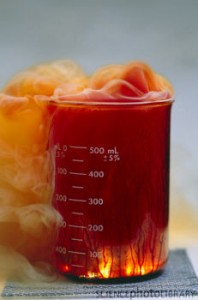 The oxidation of alcohols to carbonyl compounds holds an important place in the transformations of organic molecules, especially the selective oxidation to aldehydes or ketones without overoxidation. The importance of these transformations lies in the usefulness and reactivity of carbonyl compounds as synthons in organic synthesis. Many techniques and reagents are available for this reaction, but they tend to suffer from the need for stoichometric amounts of oxidants, as in the case of permanganate and chromate based oxidants. Ideally, the most environmentally friendly and efficient process of transforming alchools in their respective carbonyl compounds would be by employing metal catalysts that can exploit molecular oxygen as the oxidant. Although several systems have been developed that achieve this goal, they generally require additives, ligands, sacrificial substrates or high pressures of oxygen.
The oxidation of alcohols to carbonyl compounds holds an important place in the transformations of organic molecules, especially the selective oxidation to aldehydes or ketones without overoxidation. The importance of these transformations lies in the usefulness and reactivity of carbonyl compounds as synthons in organic synthesis. Many techniques and reagents are available for this reaction, but they tend to suffer from the need for stoichometric amounts of oxidants, as in the case of permanganate and chromate based oxidants. Ideally, the most environmentally friendly and efficient process of transforming alchools in their respective carbonyl compounds would be by employing metal catalysts that can exploit molecular oxygen as the oxidant. Although several systems have been developed that achieve this goal, they generally require additives, ligands, sacrificial substrates or high pressures of oxygen.
With these limitations in mind, Ma and Lei have been focusing their efforts on the development of simpler systems to achieve selective oxidations of alcohols to aldehydes and ketons (a short selection of their recent publications can be found here and here) , and recently discovered a simple methodology that only requires AlBr3 6H2O and athmospheric oxygen to efficiently convert primary benzylic alcohols in their corresponding aldehydes with high selectivity and yields.
Employing a catalyst loading of 30% in dioxane in a batch reactor at the mild temperature of 70 °C afforded conversions of primary benzylic alcohols up to 100% with total selectivity for aldehyde in several cases, with 89% being the minimum selectivity measured. Running the reaction in an argon athmosphere instead of air resulted in only trace amounts of benzaldehydes and the use of anhydrous conditions did not change the outcomes of the transformation, suggesting that moisture in solvents or gases does not affect the reaction; in addition, nitro and ether moyeties on the ring were well tolerated.
In order to gather insights into the mechanism of the reaction, a set of isotope-labelling experiments have been performed and suggested that the oxygen atom is derived from the oxidant and not from a rearrangement of the original molecule.
When the conditions were applied to secondary benzylic alcohols, the conversion rate of several diphenylmethanols into the corrisponding benzophenones suroassed 94% with selectivities up to 80%, with the main side-products being the brominated derivatives.
In summary, Ma and Lei developed a simple system that does not use chlorinated solvents, environmentally unfriendly metals or complex ligands and conditions but still provided good yields and conversions with the substrates tested. Further study on a broader substrate scope, refinement of conditions and mechanisms are underway.
Read this interesting communication in Catalysis Science & Technology.
AlBr3·6H2O catalyzed oxidation of benzylic alcohols
Yun-Mei Zhong, Heng-Chang Ma, Jin-Xia Wang, Xiao-Jie Jia, Wen-Feng Li and Zi-Qiang Lei
Catal. Sci. Technol., 2011, Advance Article DOI: 10.1039/C1CY00165E, Communication










